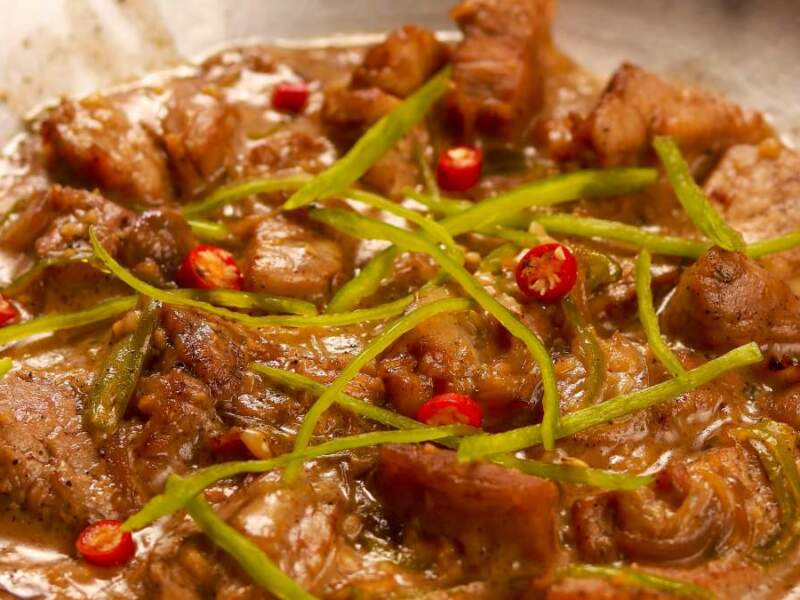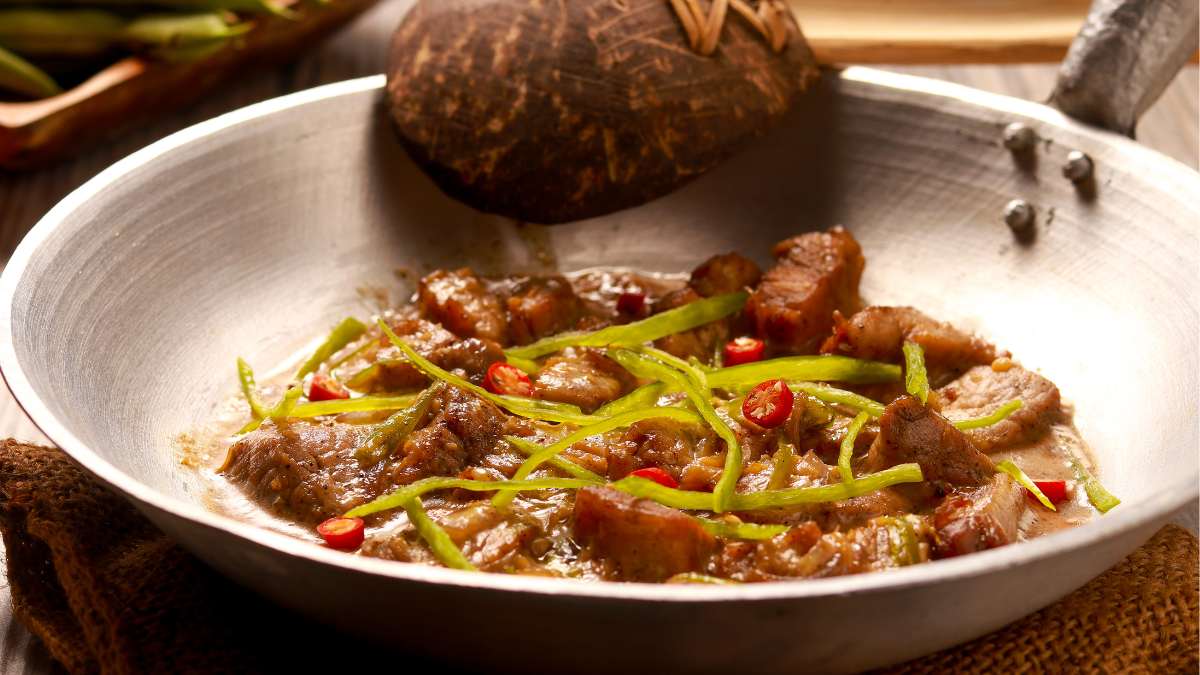Taking the Spice Trail: Unlocking the Secret Flavors of Bicol Express
Hello! Today I’m sharing a classic Filipino dish that’s full of flavor without a ton of effort: Bicol Express. We’re having train references today as the dish was invented and named after the named it after the old railway connecting Manila and Bicol.
Growing up here in Marinduque, we do most of our cooking in a traditional Filipino kawali. So when I saw interest in my Instant Pot Bicol Express recipe, I got to thinking about how to cook the Bicol Express using the traditional stovetop method using our beloved local cookware. For those unfamiliar, a kawali is a flat-bottomed sauté pan made of aluminum or carbon steel. It develops a natural non-stick patina over time and conducts heat beautifully.

As island folk, we’re used to cooking with whatever affordable materials we have on hand. Cast iron, carbon steel, and other cheap cookware are my preferences for balanced heat distribution. While an Instant Pot is very convenient, there’s nothing like the multi-tasking abilities of a good kawali. With this workhorse pan, you can brown meats, sauté aromatics, then build layered flavors right in the same vessel.
What is the Bicol Express Recipe?
Bicol Express hails from the Bicol region in the Philippines, where the local chiles are famously spicy. You’d think that this is an old tradition or an heirloom recipe but the dish is actually invented in the 1970s. Well. the version with meat, at least. The name alone conjures up images of a steam engine chugging along at full throttle — and it’s an apt description for the heat level. But fear not, you can easily dial back the spice to suit your family’s taste buds.
The key ingredients that make Bicol Express sizzle are pork, shrimp paste (alamang), coconut milk, and chiles. You’ll simmer everything together until the chiles melt into the creamy coconut mixture. It results in a rich, tropical stew-like dish that pairs perfectly with rice. Best of all, it comes together fast using pantry staples.
There are a few different styles of Bicol Express depending on preference and household. Our island version calls for tomatoes. I remember in college a dormmate who brought just pure chilies cooked in coconut milk and shrimp paste. I swear I didn’t touch chilies after that for a long time. I like to keep it simple with just the chiles, coconut milk, and a protein like pork or chicken. This makes it a lean weeknight option.
You can also adjust the pepper variety — Siling labuyo pack serious heat while Thai chilies have a milder burn, and even milder if using siling pang sigang. Play around until you find your family’s ideal spice level. Siling labuyo are those small chilies with roundish ends while the Thai chilies are those vibrant reds with a pointed ends. Siling haba or siling pansigang are those big green chilies used for cooking sinigang and dynamite chilies.

Decoding the Ingredients
Pork: The Heart of Bicol Express
At the core of Bicol Express lies succulent chunks of pork, which provide richness and depth to the dish. Opt for fatty cuts such as pork belly or shoulder for the best flavor and texture.
Coconut Milk: Creamy Goodness
Coconut milk serves as the creamy base of Bicol Express, imparting a luscious texture and subtle sweetness to the dish. Use freshly squeezed coconut milk for an authentic taste, or opt for canned coconut milk for convenience.
Chili Peppers: Heat Factor
The fiery kick of Bicol Express comes from the addition of chili peppers, which vary in intensity depending on personal preference. Thai bird’s eye chilies or Filipino siling labuyo are commonly used, but feel free to adjust the amount according to your spice tolerance.
Shrimp Paste: Umami Booster
Shrimp paste, or bagoong, adds a complex umami flavor to Bicol Express, enhancing its depth and savoriness. Look for shrimp paste in Asian grocery stores or substitute with fish sauce for a similar effect.
How to Cook Bicol Express
So here is how to cook your lola’s hearty Bicol Express using a kawali just like back home:
In your kawali, heat some oil over medium-high flame. Working in batches, brown the pork belly cubes on all sides until caramelized. Transfer to a plate.
Sauté alamang or balaw shrimp just until pink, then add to pork. If you’re using balaw make sure to clean it first by giving a quick water rinse before cooking. Some stones also tend to come with it so be careful. Balaw is freshly small shrimps or krill. In Bicol they are salted and lightly fermented.
Add onions and garlic to the hot fat left in the pan. Add tomatoes. Cook, stirring frequently, until softened. Pour in coconut milk, fish sauce, chopped chilies, and bay leaf. Season with salt and pepper.
Nestle pork and shrimp into braising liquid. Bring mixture just to a gentle simmer, then cover kawali tightly with lid. Reduce heat to low and cook for 30-45 minutes, uncovering to stir occasionally, until pork is tender and sauce has thickened.
That’s it! The long, slow simmer allows the kawali to shine by sealing in moisture and lending an unbeatable depth of flavor. Serve Bicol Express piping hot over steamed rice. Genuine Filipino home cooking at its finest.
The best part is this stew actually gets better as the chiles continue to simmer down. Feel free to make it a day ahead for even more intense flavor. I like to double or triple the batch and freeze portions for easy weeknight meals. Reheat on the stovetop or microwave and you’ve got a meal in minutes.
Tips for adjusting the spice level in Bicol Express
Worried about the chilies? Here are some tips for adjusting the spice level in Bicol Express:
- Start with fewer chiles. Thai chiles pack the most punch, so use them sparingly at first until you know how your tastebuds handle the heat. You can totally just use siling haba which are milder.
- Remove chile seeds and veins before chopping. This is where most of the heat resides.
- The longer the stew cooks, the more the chile flavor will mellow out and distribute through the coconut milk. If you go for a shorter simmer, it will be spicier.
- Pass around chili-infused condiments. Let diners doctor their own plates to preference. options like this chili garlic or chili crisp let people customize the heat.
- Go half coconut milk, half water or broth. Thinning out the coconut cream with liquid makes the chiles less concentrated.
Let me know if you have any other questions! As always, happy cooking. Be sure to sign up below for more authentic island recipes. Mabuhay!

Ingredients
Shopping List:
- 1/2 kilo pork belly, cut into 1-inch cubes
- 1 tbsp fish sauce
- 1 cup coconut milk
- 1/2 cup coconut cream
- 3 tbsp garlic, minced
- 1/4 cup tiny shrimp (balaw or alamang)
- 8-10 Taiwan Chili -sliced
- 5 pcs siling haba (sliced diagonally)
- 1 medium tomato, diced
Pantry Items:
- 1 onion, diced
- 3 cloves garlic, minced
- 2 bay leaves
- Ketchup
Tools:
- Pan or pot
- Wooden spoon
Instructions
- Season pork with salt and pepper. In a pan, cook pork over medium high heat until browned on all sides. Remove and set aside.
- In the same pan, saute shrimp paste until pink and set aside.
- Still in the same pan, sauté onion and garlic until fragrant. Add diced tomato and cook for 2 more minutes.
- Pour in coconut milk, fish sauce, chopped chilies, and bay leaf. Season with salt and pepper.
- Add pork back to the pan along with the small shrimp. Allow for a gentle simmer for about 30 -45 minutes until until pork is tender.
- Add coconut cream and allow to simmer until liquid is reduced and begins to render fat.
- Serve with rice. Enjoy!
Notes
Tips and Tricks:
For extra heat, include chopped chili peppers such as bird's eye or Thai chilies.
Stir in a spoonful of ketchup for natural sweetness and color.
Garnish with chopped scallions.
Variations:
Use chicken instead of pork for a lighter version.
Add winged bean (maravilla) or other vegetables of choice.
Add fish sauce for extra umami.
Pair With:
Rice - Bicol Express is best enjoyed over steamed white rice.
Fresh tropical fruit - Balance the richness with slices of mango or pineapple.
Leftovers: Cool completely before refrigerating for up to 3 days or freezing for 2 months. Reheat over low heat while stirring to prevent burning.
Nutritional Benefits:
Protein from pork and shrimp
Healthy fats from coconut milk
Vitamin C from tomatoes


